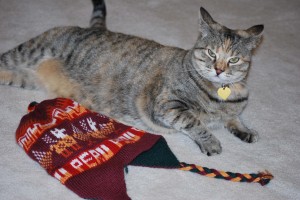 Mazey posing with a Peru Hat
Mazey posing with a Peru Hat
Not much points up spousal differences like clothing choices in the face of lousy weather.
Today, in the face of high winds, chill air and scattered showers, I gather heavy weather gear for the morning stroll with my husband: fleece-lined jeans that make my legs look like stovepipes, a wool sweater and a thick, hooded raincoat with a high collar. I top the lot with a huge cotton scarf, fleece gloves and a black-and-white newspaper-boy cap that just grazes the tips of my ears. My husband joins me, wearing a rain jacket over a thick winter coat.
As we set out from the garage, we are immediately assaulted by the wicked edge of a north wind. I tuck my chin into my collar, stick my hands in my pockets and set a brisk walking pace, a pace that says, I can’t stop moving lest I freeze in place.
“That’s a cold day,” I say.
“It’s not cold,” my husband barks back.
“In my experience, it is cold,” I answer evenly. I’m not one to tolerate having my viewpoint summarily dismissed.
“It is not cold,” he persists. “It’s November, for Pete’s sakes, not January.” He stops walking and looks me over from head to foot.
“The problem is that you are not dressed warmly enough.”
I keep walking, not wanting to lose either momentum or body heat.
“Of course, I am dressed warmly enough.” I shove my hands deeper into my pockets.
He shakes his head and trails after me.
“You need a bigger coat, warm mitts and a Peru hat.” That’s husband-speak for a woolen hat with flaps that tie under the chin. He brought a dozen home with him from a trip to Machu Pichu.
“A Peru hat would cover your ears and the sides of your face and you’d be that much warmer.”
I grunt at him, not wanting to concede the point. He’s right, of course: once my ears hands or feet get cold, the chill spreads quickly, and misery is not far behind.
“That would still leave my nose exposed though,” I parry. My poor, beleaguered nose. It is surely glowing red in hurt disbelief at the vicious change in the weather.
“I suppose that I could wear a balaclava,” I say, “Then I would look like a cross between the Michelin Man and a thug.”
“You women,” he says. “Always giving up comfort for fashion.”
Tempting though it is, I don’t touch the bait. We walk on in silence. Every so often, I break into a sideways shuffle to dull the brunt of the wind on my face and increase the blood flow to my limbs.
“You always do this,” he says as we approach the half-way point of our trek. “For as long as I have known you.” He blows out a long breath, then launches into a further lecture on how I should dress. As we round the last corner and head into the home stretch, he announces that we were going to walk around the block one more time.
“No,” I say. “I’m cold.”
“Aha!” he says. “You are giving up. How are you ever going to defeat your SAD, if you give up so easily? At this rate you will never get out of bed.”
Admittedly, that thought has crossed my mind.
“Alright,” I say. “I concede.”
When we reach our driveway, he marches me into the house. I allow him to re-dress me for our second outing. He takes off his own two coats and puts them on me, ties a Peru hat onto my thick head and finds the biggest, baddest snowmobile mitts in the house.
“There!” he says pulling on the last mitt. “You are now dressed for the weather.”
I just look at him, feeling like a three-year-old being prepped for sledding.
“You don’t suffer from Seasonal Affective Disorder,” he adds brightly. “You suffer from Under-Dressed Disorder.”
I widen my eyes, stunned by this insight,
“Oh my gosh,” I say. “You’re right. It’s UDD.”
I pause for a moment, and then break into giggles.
“And that must make me an UDDer!” I laugh so hard that I generate enough endorphins to last me the rest of the week.
And you know what? I was toasty warm on the second lap. I hate it when he’s right, but I’m simultaneously grateful for his paying attention where I haven’t and for the extra clothes that will bolster my winter regime. And, of course, for the Peru hats.
(Author’s note: This is an abridged version of an essay by the same title. )